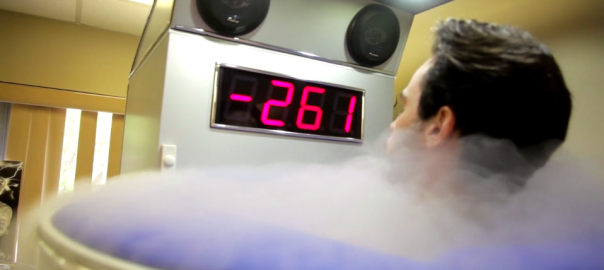Whole Body Cryotherapy: The New ‘Cool’ in Sports Medicine

The use of ice packs for a sports injury is well known in sports medicine and recreational athletic use. Cooling of the skin and its underlying tissue has a number of beneficial effects, including reduced swelling, less pain and quicker recovery of the affected area.
Recent commercial incentives have sparked a trend in what’s known as Whole Body Cryotherapy (WBC). This technique builds on this principle of cooling the injured tissue, and as the name suggests, it applies it to the full body. In WBC, a person is typically exposed to extremely low temperatures by standing in a chamber filled with cold nitrogen gas, which cools the space to temperatures below -100 ºC (212 ºF).
WBC clinics and spas are popping up all over the United States, offering 2 to 3 minutes of cryo treatment for between $40-100. Despite the hefty price tag, the treatment has gathered quite a following. Famous athletes who have been reported to use WBC include Lebron James and Christiano Ronaldo, and professional sports teams have started offering WBC to their players. This is not surprising, considering the long list of claimed benefits of WBC. These include modest effects such as reduced stress, muscle soreness and joint pain, and increased vigor, and also far more farfetched claims such as cancer treatment, boosted immunity and improved cardiovascular health—even improved physical appearance and slower aging. Users are positive, stating various subjective improvements in their wellbeing.
Mechanistic research into the effects of WBC is limited. In terms of its application in recovery from intense exercise, WBC is thought to protect the muscle tissue from a harmful inflammatory response after strenuous use. While muscle soreness after exercise is thought to result from a strong pro-inflammatory response, WBC has been shown to improve the anti-inflammatory component,1 counteracting to a certain extent any resulting tissue damage.
In 2015, the Cochrane Database of Systematic Reviews published a meta-analysis of four randomized controlled trials, which included a total of 64 physically active young adults.2 The trials all compared WBC to no WBC. The reviewing authors could not conclude that the aggregated evidence supported claims that WBC was beneficial on post-exercise soreness of subjective recovery, and larger trials are required to detect any true benefit. Besides the effect of WBC on post-exercise outcomes, WBC has been studied more elaborately in multiple sclerosis (MS) and rheumatoid arthritis (RA), where small-scale studies suggest some benefits.3
Although the research in this field generally mentions few adverse events, a 24-year-old Hawaiian woman reportedly froze to death following unsupervised use of a cryotherapy chamber in October of last year. The risks of hypothermia and frostbite are apparent, and it goes without saying that WBC requires highly-protocolled application with trained supervision. Protection of the airway, ears, groin, fingers and toes is important, as these are most vulnerable in dangerously low temperatures.
While the scientific evidence is not quite there yet, users report an impressive subjective improvement in wellbeing. Whether the health claims turn out to be true or the effects are largely placebo-related, new cryotherapy clinics are seeing a tremendous rise in demand.
References
1) Pournot H, Bieuzen F, Louis J, Mounier R, Fillard JR, Barbiche E, Hausswirth C. Time-course of changes in inflammatory response after whole-body cryotherapy multi exposures following severe exercise. PLoS One. 2011;6(7):e22748. doi: 10.1371/journal.pone.0022748
2) Costello JT, Baker PRA, Minett GM, Bieuzen F, Stewart IB, Bleakley C. Whole-body cryotherapy (extreme cold air exposure) for preventing and treating muscle soreness after exercise in adults. Cochrane Database of Systematic Reviews 2015, Issue 9. Art. No.: CD010789. DOI:10.1002/14651858.CD010789.pub2.
3) Guillot X, Tordi N, Mourot L, Demougeot C, Dugué B, Prati C, Wendling D. Cryotherapy in inflammatory rheumatic diseases: a systematic review. Expert Rev Clin Immunol. 2014 Feb;10(2):281-94. DOI: 10.1586/1744666X.2014.870036
Image courtesy of http://images.medicaldaily.com/


